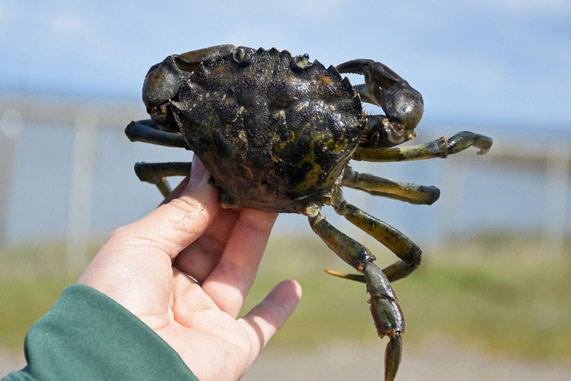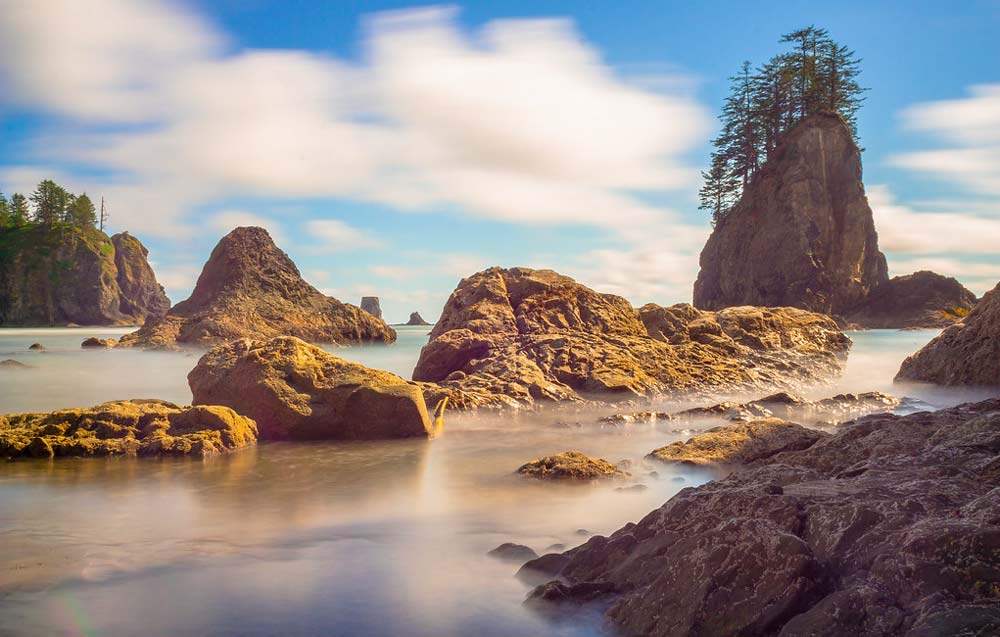Invasive Green Crab Found at Washington Coast's La Push
Published 8/21/24 at 5:55 a.m.
By Andre' GW Hagestedt, Oregon Coast Beach Connection

(La Push, Washington) – Wildlife experts in Washington State are somewhat worried about the appearance of an invasive species in a section of its coastline. The European green crab (EGC) has been found in the La Push area, after a joint survey of different tribal and state agencies looking for the crab recently captured quite a few.
Includes exclusive listings; some specials in winter
In Cannon Beach:
Includes rentals not listed anywhere else
In Manzanita, Wheeler, Rockaway Beach:
Some specials for winter
In Pacific City, Oceanside:
Some specials for winter
In Lincoln City:
Some specials for winter
In Depoe Bay, Gleneden Beach:
Some specials for winter
In Newport:
Look for some specials
In Waldport
Some specials for winter
In Yachats, Florence
Some specials for winter
Southern Oregon Coast Hotels / Lodgings
Reedsport to Brookings, places to stay; winter deals
The species has invaded many other areas along the south Washington coast, but this is the first time it's been found this in this part of the shoreline, raising concerns it could displace other native species.
During the week of August 5-8, Washington Department of Fish and Wildlife (WDFW), the Quileute Tribe, Northwest Indian Fisheries Commission (NWIFC) and Washington Sea Grant found 33 individual crabs after setting traps near the port of La Push, the Quileute Marina on the Quileute Reservation, as well as nearby areas within the Quillayute River estuary. The agencies removed the EGC, saying this week it is a “harmful crab species.”
Chelsey Buffington, WDFW’s European green crab project lead, said the agency was not entirely surprised to find them here, as they have firmly entrenched themselves in large numbers around Makah Bay to the north and just south at Willapa Bay and Grays Harbor.
The Quileute Tribe has been setting traps for the EGC since 2021 but had no captures until recently, according to Jennifer Hagen, Marine Policy Advisor/Marine Biologist with Quileute Natural Resources.
“Since trapping efforts by others to the north and south along the coast have found crab populations that number in the thousands, Quileute Natural Resources proposed to team up with WDFW staff and conduct what was dubbed a 'bio-blitz,' “ she said. “Now that we know they are here in the Quillayute River system, our management strategy will need to revisited. Ultimately our concern is the displacement of native species and species that are of cultural importance to the Quileute Tribe.”

EGC is capable of some degree of damage to local ecosystems, and a critter that has been hitting the Oregon coast as well, such as around the Siletz Bay in Lincoln City. This kind of invasive species threatens a wide variety of organisms on both the Oregon coast and Washington coast, including eelgrass, shellfish and the estuaries of the region. The latter are critical for salmon.
In general, they're found in shallow areas with less than 25 feet of water, which puts them in intertidal zones, mudflats, beaches and estuaries.
Along the Oregon coast and Washington coast, wildlife authorities really worry over the EGC's impact on Dungeness crabs – a major industry of the entire Pacific Northwest. They're capable of outdoing the Dungeness' food supply. However, WDFW noted that at trap sites set for catching the green crab, lots of Dungeness crabs were caught, along with plenty of Dungeness molts spotted in survey areas. This, WDFW said, was a definite sign the native crab population was in decent shape.
WDFW is hopeful, however, with the various tribal and state agencies working together to keep an eye on the crab.
“This detection provides an opportunity to keep EGC numbers low and avoid harm to tribal, cultural, environmental, or economic resources,” Buffington said.
WDFW, co-managers, tribes, shellfish growers, and other agencies and partners have removed more than 258,000 EGC from Washington waters so far in 2024, most from Willapa Bay and Grays Harbor on the southern Washington coast. Officials have seen a good decrease in the crab's numbers in the North Puget Sound Region, thanks to heavy trapping.

Courtesy Washington CoastSavers
There are now plans to increase the scale of the trapping season in 2025, and authorities are doing all they can to keep up monitoring efforts.
Because it is a prohibited invasive species, possessing one that is alive is illegal in Washington. However, WDFW is asking the public to not kill any crab seen in the wild that they suspect is a EGC.
“This is to protect native crabs, which are often misidentified,” WDFW said.
If you find a suspected European green crab or its shell in Washington, take photos and report it as soon as possible. Public reports and photos of suspected EGC can be submitted using the form available at wdfw.wa.gov/greencrab or through the Washington Invasive Species Council’s WA Invasives mobile app. Crab identification guides and resources are also available on the European green crab online hub and the WDFW EGC webpage.
Cannon Beach Lodging
Nehalem Bay Lodgings
Manzanita Hotels, Lodging
Three Capes Lodging
Pacific City Hotels, Lodging
Lincoln City Lodging
Depoe Bay Lodging
Newport Lodging
Waldport Lodging
Yachats Lodging
Oregon Coast Vacation Rentals
Oregon Coast Lodging Specials
More About Oregon Coast hotels, lodging.....
More About Oregon Coast Restaurants, Dining.....
 Andre' GW Hagestedt is editor, owner and primary photographer / videographer of Oregon Coast Beach Connection, an online publication that sees over 1 million pageviews per month. He is also author of several books about the coast.
Andre' GW Hagestedt is editor, owner and primary photographer / videographer of Oregon Coast Beach Connection, an online publication that sees over 1 million pageviews per month. He is also author of several books about the coast.
LATEST Related Oregon Coast Articles
1 Dead, 5 Injured In Highway 26 Crash That Backed up Oregon Coast Range Traff...Rescuers had to pull some victims up from 60 feet below the highway. Weather
Oregon State Parks Day on June 7: Free Parking and Events on Coast, Inland
Hikes, talks, BBQ, disc golf and even astronomy. Sciences, south coast events, Florence events, Astoria events, Seaside events, Cannon Beach events, Manzanita events, Rockaway Beach events, Tillamook events, Garibaldi events, Oceanside events, Pacific City events, Lincoln City events, Depoe Bay events, Newport events, Waldport events, Newport events, Yachats events, Brookings, Coos Bay, Reedsport
Spring's Weird Things Along Washington, Oregon Coast
Whale burps, ocean burps, freaky skeletons, mermaid purses, live eggs, more. Marine sciences
Destructive, Invasive Crab Found on N. Oregon Coast, Officials Ask Public's Help
Chinese mitten crab was found near Astoria. Marine sciences
Lyrid Meteors with a Possible Side of Aurora for Washington, Oregon, Coastlines
Lyrids peak on Monday, northern lights possible northern Washington. Weather
Search for Missing Teen Called Off After Involving Coast Guard from Washingto...
Two companions that tried to help also needed rescue at Long Beach. Beach safety, sciences
Coast Guard Medevacs Patient from Cruise Ship Off South Oregon Coast - Video
15 miles from Coos Bay, the man was taken to a local hospital in good condition. Beach safety
Getting Oregon Coast Stays on the 'Lowdown' - Where Lincoln City Cut Rates
Excellent Lincoln City specials abound. Lincoln City hotel reviews
Back to Oregon Coast
Contact Advertise on Oregon Coast Beach Connection
All Content, unless otherwise attributed, copyright © Oregon Coast Beach Connection. Unauthorized use or publication is not permitted



















































